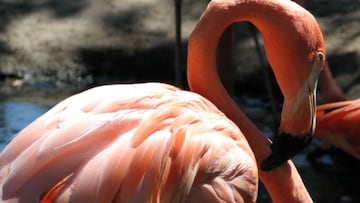Why did Hurricane Idalia cause flamingos to appear across the United States?
People have been pleasantly surprised to see something normally only seen in zoos in the US… Flamingos wading in waters as far north as Ohio.

Hurricane Idalia smashed into the Big Bend on Florida’s Gulf Coast last week. Besides bringing winds, rains and flooding that left destruction in its wake, it is thought to be the reason why bird watchers across several states from Texas up to Ohio and over to the Carolinas along with those in between have had a rare opportunity. American flamingos, which is native to the Caribbean and the north of South America, have been spotted strutting around.
Up until the 1900s, the American flamingo would migrate to parts of the Florida Everglades from the Bahamas, but with the arrival of European settlers, those populations were hunted to near extinction. The current gangly visitors are thought to be from the Yucatan peninsula, some have been spotted with tags linked to breeding populations there. But how is it that Hurricane Idalia brought them so far north?
Why did Idalia cause flamingos to appear across the United States?
Current speculation is that they could have been migrating from the Yucatan to Cuba when they got caught up in the tempest that became Hurricane Idalia. The tropical depression that eventually formed into a Category 4 hurricane was stationary for some time in the channel between Mexico and western tip of Cuba before making its march north.
While American flamingos generally travel short distances when they migrate, they are strong birds and can stay aloft for periods of time without feeding. It is “fairly common phenomenon” for birds to get caught up in the colossal tropical storms, but not flamingos according to Nate Swick, the American Birding Association’s digital communications manager.
He thinks what likely happened is that the flamingos went with the wind, perhaps within the eye of the storm, and kept going instead of wasting energy until the hurricane broke apart. This isn’t the first time it has happened either. Swick told NPR that in 2019, Hurricane Barry drove a group of flamingos from the northern part of the Gulf of Mexico to western Tennessee and Missouri.
Where have flamingos been spotted in the United States?
While flamingos are once again a relatively common sight in southern Florida and the Keys, and are expanding north little by little, one doesn’t expect to see them in Ohio. “Once the pair of birds were found in southern Ohio, sort of everything kind of broke loose,” Swick said. Apart from popping up in the southern part of the Buckeye State, there have been sightings in Alabama, both North and South Carolina, Kentucky, across Florida, Tennessee, Texas and Virginia.
For those that are excited to catch a glimpse of the rare sight, the Audubon Society of Florida kindly asks that you “give them room.” Think about like when you take a wrong turn and need to get your bearings, the birds are probably a bit stressed out and “disturbance expends valuable energy” while trying to survive in a new environment.
Swick says like the last time with Barry, they’ll probably hang around for a bit but eventually make their way back which they are more than capable of. “I think the flamingos are likely to start heading towards the coast,” he told NPR. “Whether or not they know which direction to go, I don’t know. Birds are capable of things that we cannot imagine.”






